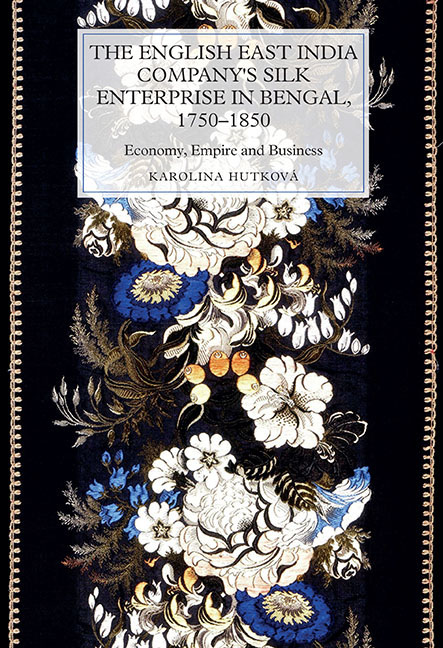Book contents
- Frontmatter
- Contents
- List of Illustrations
- Acknowledgements
- List of Abbreviations
- Measures and Currencies
- Introduction: Companies, Political Economy and the Great Divergenc
- Chapter 1 The Early Modern Silk Industry, Trade and Mercantilism
- Chapter 2 Empire, the English East India Company, and Bengal Raw Silk
- Chapter 3 Bengal, Piedmont and the English East India Company
- Chapter 4 The Bengal Silk Industry and the English East India Company
- Chapter 5 Filatures and Performance in the Bengal Silk Industry
- Chapter 6 The Bengal Silk Industry and British Laissez-Faire Policies
- Chapter 7 Bengal Raw Silk and British Demand in the Nineteenth Century
- Conclusion
- Appendix A Description of the Piedmontese Reeling Machine by Dionysius Lardner
- Appendix B Average Prices of Bengal Raw Silk on the British Market According to the Type of the Silk, 1796–1856
- Appendix C Return on Investment Analysis
- Appendix D Comparison of Manufacturing Costs at the EEIC's Experimental Filature and Common Filature in its Vicinity, 1832
- Appendix E Mechanisation of Silk Throwing and Weaving in England and Scotland, 1856
- Appendix F Types of Silkworm Reared in Bengal Silk Districts, 1818
- Appendix G Glossary
- Bibliography
- Index
- WORLDS OF THE EAST INDIA COMPANY
Chapter 7 - Bengal Raw Silk and British Demand in the Nineteenth Century
Published online by Cambridge University Press: 31 August 2019
- Frontmatter
- Contents
- List of Illustrations
- Acknowledgements
- List of Abbreviations
- Measures and Currencies
- Introduction: Companies, Political Economy and the Great Divergenc
- Chapter 1 The Early Modern Silk Industry, Trade and Mercantilism
- Chapter 2 Empire, the English East India Company, and Bengal Raw Silk
- Chapter 3 Bengal, Piedmont and the English East India Company
- Chapter 4 The Bengal Silk Industry and the English East India Company
- Chapter 5 Filatures and Performance in the Bengal Silk Industry
- Chapter 6 The Bengal Silk Industry and British Laissez-Faire Policies
- Chapter 7 Bengal Raw Silk and British Demand in the Nineteenth Century
- Conclusion
- Appendix A Description of the Piedmontese Reeling Machine by Dionysius Lardner
- Appendix B Average Prices of Bengal Raw Silk on the British Market According to the Type of the Silk, 1796–1856
- Appendix C Return on Investment Analysis
- Appendix D Comparison of Manufacturing Costs at the EEIC's Experimental Filature and Common Filature in its Vicinity, 1832
- Appendix E Mechanisation of Silk Throwing and Weaving in England and Scotland, 1856
- Appendix F Types of Silkworm Reared in Bengal Silk Districts, 1818
- Appendix G Glossary
- Bibliography
- Index
- WORLDS OF THE EAST INDIA COMPANY
Summary
So that those districts in England principally employed in making the coarse description of commodity we have been making for the last few years may be in a state of prosperity, while Spitalfields, where you are used to consume Italian silks in making velvets and figured articles, may not be in a state of prosperity?
The above excerpt from an inquiry into the state of the silk industry carried out in 1832 by the House of Commons Select Committee on the Silk Trade is a fitting depiction of the state of British silk weaving in the middle of the nineteenth century. Producers of crape, ribbons and other smaller silk items of middling quality were able to make profits, whereas producers of high-quality, broad silk weaves were facing difficulties. Since this book is concerned not only with raw silk production in Bengal but also with the link between the British and Bengal silk industries, it is important to explore the development of the British silk industry in the nineteenth century. This is crucial, particularly in assessing whether demand for Bengal raw silk was stable or diminishing. Research into the nineteenth-century silk industry has shown a high degree of complementarity between raw silk-producing regions and weaving centres – China and France, and Japan and the USA. As the previous chapters have shown, the British and Bengal silk industries had a strong connection in the eighteenth century. It is essential to assess whether the political economy changes of the post-mercantilist era weakened this link and if the structural changes to the British silk industry decreased the demand for Bengal raw silk.
In the nineteenth century the British silk industry became one of the targets of critics of mercantilism. It was argued that mercantilist regulation was to blame for the stagnation of the British silk industry and that only the disbanding of protective measures and a reduction of import duties on finished silks could revive the industry. The whole debate was conceptualised as one focused on labour, the poverty and destitution of weavers and throwsters, a debate on the role of Spitalfields, and competition with France or Continental Europe in general.
- Type
- Chapter
- Information
- The English East India Company's Silk Enterprise in Bengal, 1750–1850Economy, Empire and Business, pp. 173 - 198Publisher: Boydell & BrewerPrint publication year: 2019



